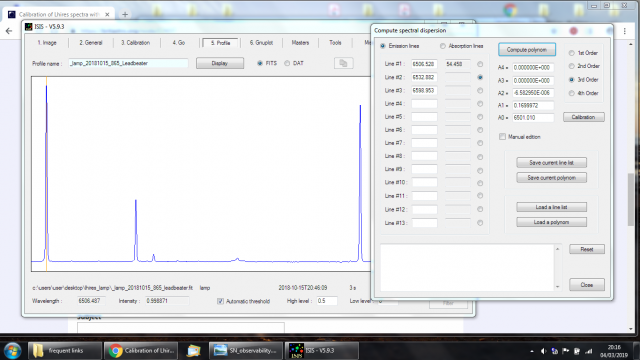› Forums › Spectroscopy › Calibration of Lhires spectra with impoverished calibration spectrum
- This topic has 4 replies, 2 voices, and was last updated 5 years, 1 month ago by
 Kevin Gurney.
Kevin Gurney.
-
AuthorPosts
-
4 March 2019 at 12:38 pm #574269
 Kevin GurneyParticipant
Kevin GurneyParticipantThe scenario is as follows: H alpha is on the left of the spectrum in order to see a Helium line at 6678 and the calibration spectrum therefore only has two lines. In general three lines are required to give the much better fit of a quadratic. How can this be overcome?
Fortunately there are a number water absorption lines around Ha which are well documented in an image in the Isis database which can be recruited. To do this, I adopted the following approach:(i) Create a composite of the star and calibration spectra (use the ‘add two spectra’ in Isis tools)
(ii) Run this image through the programme but with ‘Spectral Calibration’ unchecked, and with ‘Sky not removed’ checked (in General tab).
(iii) Populate the line list in the ‘dispersion’ panel (under Profile tab) with the two lines in the calibration spectrum, and at least one of the water absorption lines. The locations are in pixels here, not wavelength.
(iv) Use the ‘calculate polynomial’ to get the coefficients for dispersion (quadratic is fine)
(v) Go back and process the real data in the normal way (be sure to check ‘spectral calibration’ and uncheck ‘sky not removed’, and select ‘Predefined dispersion relation’ as the calibration method.Seems to work, but maybe I have missed a simpler trick?
Kevin
4 March 2019 at 2:54 pm #580793 Robin LeadbeaterParticipant
Robin LeadbeaterParticipantHi Kevin,
It should work ok provided you don’t see any fixed offset between water and lamp lines. (You would see this for example at H alpha if you always need to make a consistent correction using the water lines.). Don’t forget to switch between absorption and emission for the specific line you are measuring in the dispersion calculation tab. I would suggest calculating the dispersion just on the reference star where the SNR in the water lines is likely to be higher and then using this calculated dispersion on the target with one of the neon lines as a reference point to correct for any flexure offsets.
Alternatively have you tried a long exposure with the Ne lamp to see if you can see any weak Ar lines to use instead of the Ne lines? (I could see some with my Ne lamp but they are more obvious now I have upgraded to the NeAr lamp)
Cheers
Robin
4 March 2019 at 3:50 pm #580795 Kevin GurneyParticipant
Kevin GurneyParticipantHi Robin
Worth looking at systemic difference between water and main lines…
I didnt get the part about switching between emission and absorption… All I do is enter the pixel-wise location of water and calib image lines into the table, having determined them from the combo image with no calibration. Then press ‘calculate polynomial’ and obtain the dispersion. I am not using Isis to actively seek the lines in the image. In this way I get a function that is fixed at both ends (and the centre). I do, however, then specify one of teh calib image lines as a reference point, but apparently this is optional with the ‘predefined dispersion’ option – you can put zero as the wavelength and it doesnt try and pick up any reference (at least that’s how I read it)
Kevin
4 March 2019 at 8:40 pm #580798 Robin LeadbeaterParticipant
Robin LeadbeaterParticipantHi Kevin,
With the manual dispersion function in ISIS you double click either side of each line in the uncalibrated (combo) spectrum and ISIS calculates the exact pixel position of the centroid of the line and enters the value in the table. You have to tell it to look for either an emission or absorption line within the two clicked positions though (buttons at the top of the window) so you would need to click “absorption” before measuring the water line positions and “emission” before measuring a lamp line.

Yes, if you set the reference line to 0,0 it just uses the predefined dispersion equation but if your dispersion was measured on a reference star with the telescope pointing in a different direction to the target, this can be out by a constant shift due to flexure so adding a reference point using a lamp spectrum corresponding to the target will correct for this. (correcting the constant in the polynomial)
Robin
4 March 2019 at 11:43 pm #580799 Kevin GurneyParticipant
Kevin GurneyParticipantHi Robin
Great tip! I get it now….
I had measured the line positions by just positioning the cursor and noting the value….
Nevertheless, I was quite pleased with the result. In the final spectrum, the water lines were as expected, and I measured Halpha shifts associated with radial velocities given in Simbad.
Kevin
-
AuthorPosts
- You must be logged in to reply to this topic.
